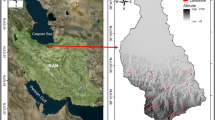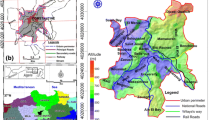Abstract
The purpose of this study is to evaluate and to compare the results of multivariate (logical regression) and bivariate (landslide susceptibility) methods in Geographical Information System (GIS) based landslide susceptibility assessment procedures. In order to achieve this goal the Asarsuyu catchment in NW Turkey was selected as a test zone because of its well-known landslide occurrences interfering with the E-5 highway mountain pass.
Two methods were applied to the test zone and two separate susceptibility maps were produced. Following this a two-fold comparison scheme was implemented. Both methods were compared by the Seed Cell Area Indexes (SCAI) and by the spatial locations of the resultant susceptibility pixels.
It was found that both of the methods converge in 80% of the area; however, the weighting algorithm in the bivariate technique (landslide susceptibility method) had some severe deficiencies, as the resultant hazard classes in overweighed areas did not converge with the factual landslide inventory map. The result of the multivariate technique (logical regression) was more sensitive to the different local features of the test zone and it resulted in more accurate and homogeneous susceptibility maps.














Similar content being viewed by others
References
Afifi AA, Clark V (1998) Computer aided multivariate analysis. Chapman Hall, London, 455 pp
Aleotti P, Chowdhury R (1999) Landslide hazard assessment: summary review and new perspectives. Bull Eng Geol Env 58:21–44
Atkinson PM, Massari R (1998) Generalized linear modeling of susceptibility to landsliding in the central Apennines, Italy. Computers and Geosciences 24(4):373–385
Bonham-Carter GF (1996) Geographic information systems for geoscientists, modeling with GIS. Pergamon Press, Oxford, 398 pp
Brabb EE (1984) Innovative approaches to landslide hazard and risk mapping. In: Proc 4th Int Symp on Landslides. Canadian Geotechnical Society, Toronto, vol 1, pp 307–324
Carrara A (1983) Multivariate models for landslide hazard evaluation. Mathematical Geology 15(3):403–427
Carrara A (1988) Landslide hazard mapping by statistical methods: a “Black Box” approach. In: Workshop on natural disaster in European Mediterranean countries, Perugia, Italy. Consiglio Nazionale delle Ricerche, Perugia, pp 205–224
Carrara A, Merenda L (1974) Metodologia per un censimento degli eventi franosi in Calabria. Geologia Applicata e Idrogeologia 10:237–255
Carrara A, Cardinalli M, Detti R, Guzzetti F, Pasqui V, Reichenbach P (1990) Geographical information systems and multivariate models in landslide hazard evaluation. In: ALPS 90 Alpine Landslide Practical Seminar, Sixth International Conference and Field Workshop on Landslides, Aug 31–Sept 12, Milan, Italy. Universita degli Studi de Milano, pp 17–28
Carrara A, Cardinalli M, Detti R, Guzzetti F, Pasqui V, Reichenbach P (1991) GIS techniques and statistical models in evaluating landslide hazard. Earth Surf Proc Land 16(5):427–445
Carrara A, Cardinali M, Guzzetti F (1992) Uncertainity in assessing landslide hazard and risk. ITC J 2:172–183
Dai FC, Lee CF, Xu ZW (2001) Assessment of landslide susceptibility on the natural terrain of Lantau Island, Hong Kong. Environ Geol 40(3):381–391
Erendil M, Aksay S, Kuşçu İ, Oral A, Tunay G, Temren A (1991) Bolu masifi ve çevresinin jeolojisi. MTA Rap No:9425 (unpublished)
Gupta P, Anbalagan R (1997) Slope stability of Tehri dam reservoir area, India using landslide hazard zonation (LHZ) mapping. Q J Eng Geol 30:27–36
Gupta RP, Joshi BC (1990) Landslide hazard zoning using the GIS approach – A case study from the Ramganga catchment, Himalayas. Eng Geol 28:119–131
Guzzetti F, Carrara A, Cardinalli M, Reichenbach P (1999) Landslide hazard evaluation: a review of current techniques and their application in a multi-case study, central Italy. Geomorphology 31:181–216
Ives JD, Messerli B (1981) Mountain hazard mapping in Nepal: introduction to mountain research project. Mountain Research and Development 1(3–4):223–230
Kienholz H (1977) Kombinierte geomorphologische gefahrenkarte 1:10,000 von Grindelwald. Catena 3:265–294
Kienholz H (1978) Maps of geomorphology and natural hazards of Grindelwald, Switzerland, scale 1:10,000. Arctic Alpine Res 10:169–184
Kienholz H, Bichsel M, Grunder M, Mool P (1983) Kathmandu Kakani area, Nepal: mountain hazards and slope stability map. United Nations University, Mountain Hazards mapping project, map 4, Scale 1:10,000
Kienholz H, Mani P, Klay M (1988) Rigi Nordlene, Beurteilung der naturgefahren und waldbaliche prioritatenfestlegung. In: Proc INTRAPRAEVENT, Graz, Austria, vol 1, pp 161–174
Kleinbaum DG (1991) Logistic regression a self-learning text. Springer, Berlin Heidelberg New York
Kobashi S, Suzuki M (1988) Hazard index for the judgment of slope stability in the Rokko Mountain region. In: Proc INTERPRAEVENT, 1988, Graz, Austria, vol 1, pp 223–233
Lee S, Min K (2001) Statistical analysis of landslide susceptibility at Yongin, Korea. Environ Geol 40:1095–1113
Malgot J, Mahr T (1979) Engineering geological mapping of the west Carpathian landslide areas. Bull Int Assoc Eng Geologists 19:116–121
Meneraud JP, Calvino A (1976) Carte ZERMOS, zones exposees a des risques lies aux mouvements du sol et du sous-sol a 1:25,000, region de la Moyenne Vesubie (Alpes Maritimes). Bureau de Recherches Geologiques Minieres, Orleans, France, 11 pp
Pachauri AK, Pant M (1992) Landslide hazard mapping based on geological attributes. Eng Geol 32:81–100
Rupke J, Cammeraat E, Seijmonsbergen AC, van Westen CJ (1988) Engineering geomorphology of the Widentobel catchment, Apenzell and Sankt Gallen, Switzerland: a geomorphological inventory system applied to geotechnical appraisal of slope stability. Eng Geol 26:33–68
Soeters R, van Westen CJ (1996) Slope instability recognition analysis and zonation. In: Turner KT, Schuster RL (eds) Landslides: investigation and mitigation. Transportation Research Board National Research Council, Special Report No 247, Washington, DC, pp 129–177
Spiegelhalter DJ (1986) Uncertainty in expert systems, in artificial intelligence and statistics. Addison Wessey, Reading, MA, pp 17–55
Stevenson PC (1977) An empirical method for the evaluation of relative landslide risk. Bull Int Assoc Eng Geol 16:69–72
Süzen ML (2002) Data driven landslide hazard assessment using geographical information systems and remote sensing, M.E.T.U. PhD Thesis, Unpublished, 196 pp. http://www.metu.edu.tr/~suzen
Süzen ML, Doyuran V (2004) Data driven bivariate landslide susceptibility assessment using geographical information systems: a method and application to Asarsuyu catchment, Turkey. Eng Geol (in press)
Süzen ML, Yeşilnacar E (2002) A landcover extraction scheme for landslide hazard assessment using satellite image components. Int Conf Environ Problems of the Mediterranean Region, Near East University, Nicosia, North Cyprus, 11–16 April, (in press)
Van Westen CJ (1992) Medium scale landslide hazard analysis using a PC based GIS: a case study from Chinchina. In: Alzate JB (ed) Proc 1st Simposio Internacional sobre Sensores Remotes y Sistemas de Informacion Geografica (SIG) para el Estudo de Riesgos Naturales, Bogota, Colombia. Instituto Geografico Agustin Codazzi, Bogota, vol 2, 20 pp
Van Westen CJ (1993) Application of geographic information systems to landslide hazard zonation. ITC Publication No 15, International Institute for Aerospace and Earth Resources Survey, Enschede, The Netherlands, 245 pp
Wrigley N (1984) Categorical data analysis for geographers and environmental scientist. Longman, Harlow
Yin KL, Yan TZ (1988) Statistical prediction model for slope instability of metamorphosed rocks. In: Bonnard C (ed) Proc 5th Int Symp Landslides, Lausanne. Balkema, Rotterdam, vol 2, pp 1269–1272
Acknowledgements
This study was financially supported by the Middle East Technical University Research Project No: AFP-99–03–09–04.
Author information
Authors and Affiliations
Corresponding author
Rights and permissions
About this article
Cite this article
Süzen, M.L., Doyuran, V. A comparison of the GIS based landslide susceptibility assessment methods: multivariate versus bivariate. Env Geol 45, 665–679 (2004). https://doi.org/10.1007/s00254-003-0917-8
Received:
Accepted:
Published:
Issue Date:
DOI: https://doi.org/10.1007/s00254-003-0917-8




